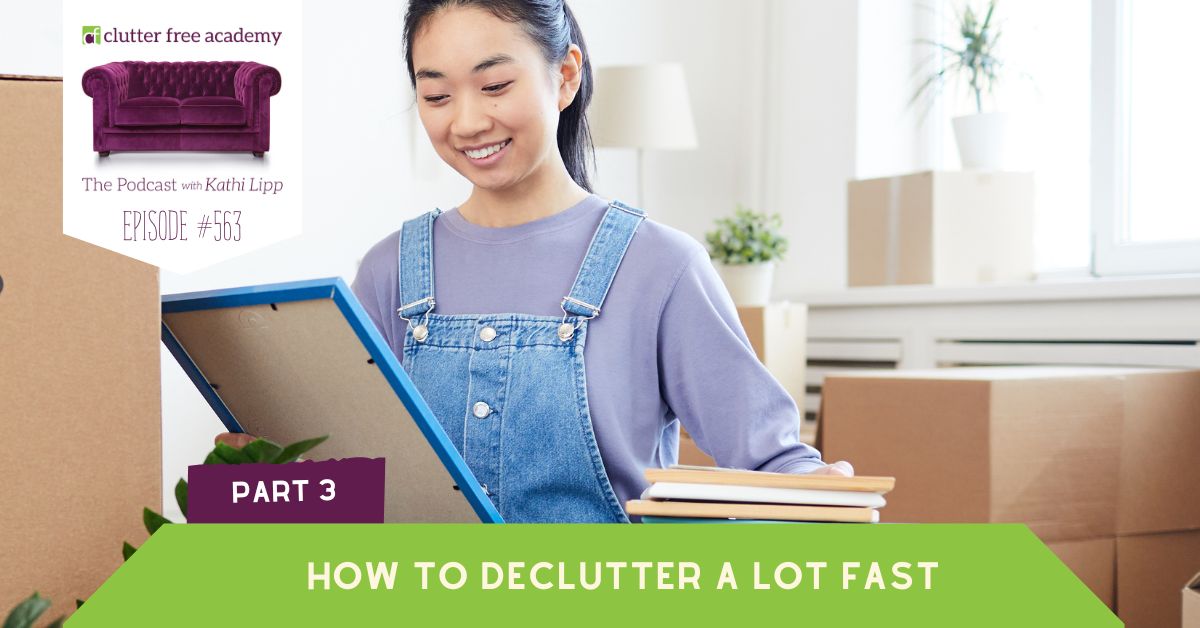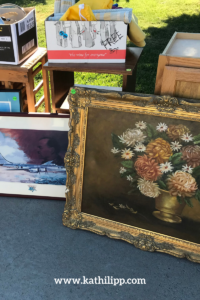Is your clutter making a comeback…again? You tidy up, you declutter, but somehow, all those piles and projects sneak right back into your life. If you’ve ever felt defeated when the mess keeps resurfacing, this episode will speak right to your heart. Join Kathi and...

#606 The Container Principle
We all have stuff we want to keep, whether for daily use or for posterity. The question is, do we have room for it? How much is too much?
Don’t let your abundance take over your abode. Tune in to hear Kathi and Roger as they discuss:
- How to contain t-shirts, tech goo, and other treasures
- What qualifies as a container, anyway?
Sign up here to be notified when the next episode is released.
The Accidental Homesteader: What I’ve Learned About Chickens, Compost, and Creating Home
Homesteading [hohm-sted-ing]
noun
1. an act or instance of establishing a homestead.
2. the act of loving where you live so much that you actively ignore the fact that your house is trying to kill you on a regular basis.
For Kathi Lipp and her husband, Roger, buying a house in one of the most remote parts of Northern California was never part of the plan; many of life’s biggest, most rewarding adventures rarely are.
Kathi shares the hard-won wisdom she’s gained on her homestead journey to help you accomplish more at home, gain fresh perspective, and give yourself grace in the process. Here’s a handful of the lessons Kathi shares:
- Prepare before the need arises
- Everything is always in process, including us
- Your best household solution is time and patience
- You don’t have to do everything the hard way
- Be open to new and better ways of doing things
- A lot of small changes make a huge difference.
Highly practical, humorous, and inspirational, The Accidental Homesteader will encourage you to live with more peace, joy, and contentment.
Order your copy of The Accidental Homesteader: What I’ve Learned About Chickens, Compost, and Creating Home here.
Favorite Links:
Clutter Free Resources:
Learn more about Clutter Free for Life
Join our Clutter Free Academy Facebook Group
Do you limit how many containers you allow yourself to have? Why or why not? Share your answer in the comments.
Let’s stay connected
To share your thoughts:
- Leave a note in the comment section below.
- Leave an honest review on iTunes. Your ratings and reviews really help and I read each one.
Subscribe on iTunes or subscribe to our newsletter now.
Meet Our Guest
Roger Lipp

Transcript
Kathi (00:29.271)
Well, hey friends, welcome to Clutter-Free Academy, where our goal is to help you take small, doable steps to live every day with less clutter and more life. And I am here with my Clutter-Free Partner in Crime. It is Roger Lipp. Hey, Rog.
Roger (00:44.101)
Hey, good to be here.
Kathi (00:46.363)
Okay, we are talking about one of my favorite ways of thinking about our stuff This is this is gonna be life-changing for some of you. Maybe others not so much, but for me life-changing and I yeah, I Thought when we moved from 1,400 square feet to this Monstrosity, I don’t know if it’s a monstrosity that implies it’s bad
this really large house that-
Storage would not be a problem anymore. That is not the case.
Roger (01:24.119)
The storage just became a different problem.
Kathi (01:26.455)
My goodness, right? Okay, so how do you view the storage problem in our house?
Roger (01:34.178)
Well, we’ve got a couple of different things. We have different things that we need to store, the big outside stuff that now needs a storage place. And we have a different use for the house because of retreats and things. So that creates a different storage challenge for us. And just the configuration of the storage, where is storage? That’s different here than it was in San Jose too. So we have to kind of think differently.
Kathi (01:41.868)
Yes.
Kathi (01:57.731)
Yeah.
Kathi (02:03.447)
Yeah, and you know, I think another factor for us, which it is for most people, but was not a problem in San Jose, is out of season storage. You know, our out of season storage in San Jose were a couple of sweaters and an umbrella. And here, we have, you know, snowblowers and heavy coats. And it’s just a different way of living. And I know most people,
Roger (02:13.858)
Hmm.
Roger (02:19.917)
What?
Kathi (02:33.007)
This was God’s gift to me to understand the clutter situations that we did not have in San Jose, where if it got to be 68 degrees, there was deep concern on the local weather channels. Like, how are we going to brace for the cold? Now, I will say there has been a lot of weather in San Jose this past week with all the rains and things like that.
For the most part, it’s very temperate. And so I wanna discuss how we’ve had to kind of figure out our new vibe for storage. And this is the container principle. And how this relates to clutter-free living is we are not storing more stuff than we have space for. Now, I will have to say, the people who lived here before us,
did not live here year round. So if it snowed 14 feet, they just didn’t stay here until the snow melted. That’s not really our option. We have to have ways of dealing with the snow and things like that. So the concept of the container principle is that we let the container dictate the quantity of items.
So let me give a very basic example. A t-shirt drawer. I have a lot of t-shirts. I wear a lot of t-shirts. You know, I’m not getting dressed up every day here on the mountain, so I have a lot of t-shirts. And I have one drawer for t-shirts. And I am not allowing myself to have more t-shirts than I have room in the drawer. And so that’s just the basic principle.
Roger (03:57.694)
Yeah.
Kathi (04:27.619)
that the container is the dictator of how much we have. So I have more t-shirts than I have, say, socks. You know, my t-shirts take up more room than my socks. And so I have a smaller space for my socks than I do for my t-shirts, but it’s the container that dictates it. And if I’ve got too much of something, I need to get rid of something. So, yeah.
Roger (04:55.234)
I love this principle because it just makes it so clear and so simple of, uh, do I have too much of something? Well, does it fit in the container? Uh,
Kathi (05:04.983)
Yes. Right. And if it doesn’t, then we keep the best and we get rid of the rest.
Roger (05:12.33)
That’s right. And the container size is up to you. It was a decision that you made. It’s not, so it’s not entirely dictated by the size of the container. You dictated the size of the container and now the size of the container dictates how much, how many t-shirts you have.
Kathi (05:18.032)
Mm-hmm.
Kathi (05:24.291)
Right. Yes.
Kathi (05:30.559)
Right and is this a reasonable size container for my t-shirts? One really big drawer. Yes, it is but It would be very easy for me to keep four really big drawers of t-shirts Because I collect t-shirts. I don’t set out to collect them But you know, I think of a few t-shirts i’ve received recently we got t-shirts made for your 60th birthday when we went to Disneyland so we have those t-shirts we I have a t-shirt
for teaching at a writer’s conference called the Red Bud Writers Conference. Like those are just ones that I didn’t even purchase, they were just acquired. And so, and I wanna keep both of those, but the container says, well, Kathi, you can’t keep both of those and keep all the shirts you’ve had previously. So decisions must be made. And I mean, but here’s what I would do in the past is,
If I had too much of a thing, I would just buy another container. And that container had to be contained someplace. And that was usually as storage in the garage or, and there are things that it’s appropriate to store in the garage. But extra t-shirts is not one of them. We had this problem many years ago when we first combined households
in San Jose, because when we got married, we combined households. And I took a count, and I think I’m remembering correctly, we had 13 bookshelves.
Roger (07:06.946)
That’s a lot of bookshelves. And let me be clear. I think I may have added one bookshelf to that equation as we joined houses.
Kathi (07:08.367)
That’s too many bookshelves.
Kathi (07:13.712)
Hahaha
Kathi (07:18.403)
Yeah, I don’t think when we originally combined that we had 13, but this was back in the day where people were sending me books, you know, lots and lots of books. People still send me books, but it’s, publishers tend to send PDFs instead of the actual book these days. And so, uh, I just, instead of getting rid of books,
because these were my friends. These books were written by my friends and I’d be a terrible friend if I got rid of, it’s ridiculousness. But I just kept getting bookshelves and putting them in the kids’ room, in our bedroom. And when I put one in the, yeah, were you gonna say where I put, no, you go ahead. It’s.
Roger (08:00.099)
No, yeah, you go ahead. You can mess. We knew it was good.
Kathi (08:06.371)
I had one in the bathroom. And I said I was just gonna use it for like decorator stuff, but some magazine, yeah. Yes, so my deep confession is, I think it was either 12 or 13 bookshelves. It was ridiculous. And so that’s an example of the container meeting the clutter.
Roger (08:17.908)
It became a bookshelf.
Kathi (08:33.099)
instead of the container meeting the need. And so I wanna, yeah, go ahead.
Roger (08:36.194)
So I love the idea here that a container isn’t necessarily something with a lid. The container is the bookshelf, the garage, the attic, whatever you decide the container is. So when we’re talking about container, that’s kind of the idea here.
Kathi (08:42.592)
No.
Kathi (08:48.004)
Yes.
Kathi (08:52.675)
Yeah, and you know, I think that this really helps us in a couple of ways for decluttering. When I am too busy, I don’t declutter our pantry enough. And I just did it this morning. And every, oh, it did, I don’t know why. That was very weird. She’s like, what are you, she has seen me declutter the pantry before.
Roger (09:06.69)
kind of freaked Moose out. Yeah, she was very disturbed.
Roger (09:17.992)
Yes.
Kathi (09:19.311)
But here’s what I know happens. When you have a container that is too full and our pantry was too full, what happens is you don’t know what’s in there anymore and you just keep getting the same five or six items out and at the front surface because that’s the easiest and the rest of it doesn’t get used. And in a pantry, that’s really bad because food spoils. And so you need to be able to see what you have.
Roger (09:33.694)
of the front surface.
Kathi (09:49.475)
use what you have. It’s the same with like a t-shirt drawer. If I’ve got too many t-shirts, what ends up happening is I don’t put them away. Like I’ll just live out of a folded laundry basket, but it’s still a laundry basket because it’s too much effort because I have to shove down clothes or whatever. And so…
I really feel like the benefit is there is easier decision making because you don’t have as much stuff. You know where everything is. All my t-shirts go in this one drawer. They don’t go in seven drawers. They go in this one drawer. And it reduces clutter because if you say I’m only going to keep what properly fits in this container, then you’re making decisions to get rid of some of the stuff. You know, let’s all talk about the t-shirts that are on the bottom.
You know, that you got, I don’t know. It’s ridiculous, you guys. I had a beer t-shirt for a long time. I…
Roger (10:52.08)
I remember when you got that.
Kathi (10:53.731)
Yes, we were out to lunch at a, we were hosting a speakers retreat and we were in Arizona and our brand new waitress dumped an entire pitcher of water on me. And the manager came over and said, Hey, would you like a t-shirt? And this was a pub. And so it said, good people drink good beer. It’s like.
which is hilarious because yeah, I had a sip of beer one time like my latter year in college and I was like, well, that’s enough. But I forgot I was wearing this t-shirt when we went to go greet everybody at our Christian speaking conference. And lots of people have pictures with me saying, good people drink good beer at the leverage conference, which is great.
Roger (11:23.118)
because we don’t drink beer.
Kathi (11:45.911)
So like, why did I keep this t-shirt for so long? I needed it for an emergency. I’m not opposed to it. If you like a good beer, hey, more power to ya. But that is not my journey. So, no, we don’t anymore. I decluttered it. I made the hard decision. But those are the kinds of t-shirts that would go to the bottom. I’d never wear them. And so, or the t-shirt that has the scratchy tag or.
Roger (11:58.838)
Let us know we have a t-shirt for you.
Okay, all right.
Kathi (12:14.171)
the t-shirt that has the writing coming off of it. And we keep them because what we do is we justify their journey. We say, oh, well, I could wear that if I am painting, or I could wear that to bed. So we have all these conditions on it, but probably we’re just wearing the same thing 75 times.
Roger (12:35.126)
Now, it’s not just you. I have a container as well of stuff that kind of follows that same path. And it’s, oh, yeah, it’s the TechGoo box. This is a box. So you get that misplaced power adapter. And I don’t know what device it goes to. Do I throw it away? Well, what if I find a device that doesn’t have a power adapter? So it goes in the box.
Kathi (12:44.623)
Oh, do tell.
Kathi (12:48.109)
Oh yeah. Yeah.
Kathi (12:58.818)
Yeah.
Roger (13:04.406)
But we limit how many things we save by having a set size box for tech goo. And, and let me be clear, this is just miscellaneous tech goo. We have sound equipment and stuff that has tech that doesn’t go in that box. It has its own box, but the miscellaneous lost home tech goo box is a fixed size under a bed.
Kathi (13:04.722)
Oh
Kathi (13:14.063)
Yes.
Kathi (13:21.785)
Right.
Kathi (13:30.043)
We both have our clutter sins, guys. Okay, so let’s talk about how do you get rid of stuff out of the container. One of the things I’ve had to do, I have shelves for my shoes. Right now I have too many shoes. I just do.
And so what I’m doing is I am going through, I just threw away a pair of shoes that were falling apart, but they were comfortable, but they were falling apart. So it was time to get rid of them. And I need to probably get rid of three more pairs of shoes. And guys, we all make mistakes. We buy the shoes, they aren’t as comfortable as we thought, they don’t go with everything.
So what you’re doing is you’re keeping the things that you wear over and over and over again, and you’re getting rid of the things that are just taking up space on the shelf. So feel good knowing you have enough shoes that you can get rid of some. And I always try to remind myself, those shoes that are the least worn for me will be somebody else’s most worn shoes. When they…
take them to, we have a place called Snowline that we donate to. And so it’s really important to, because here’s what I know, it takes me longer to get ready, it takes me longer to clean my closet, it takes me longer to do everything when I have too much stuff, especially stuff that I’m not using. And we have all those little conditions on it. Well, you know, if somebody gets married on a beach, well, these would be the perfect shoes.
We don’t know people getting married on beaches these days. No, no. It’s time to let it go. Let it go. Okay. So Roger, with the container for your tech goo, here’s what I always worry about. Like with tech stuff. And I think I just came up with a solution. Is that, but what if I need, like what if this is the one cord?
Kathi (15:40.439)
And so I wonder if we put things in there and we say, we put it in a Ziploc bag and we say the date on this is June 1st, 2024. And if we haven’t pulled it out of there in a year, we can safely assume that we are not going to die. This is not a life-saving device for us. How does that feel to you?
Roger (15:58.958)
this. That’s not a bad idea. Yeah, yeah, it would it would create a lot of plastic bags. But I think it’s worth trying. Yeah. You know, yeah, yeah. And the same principle in your closet is, you know, you how you hang your clothes. And that’s how you know, but you can’t do that in a box of tech goo. So how do you simulate that? Yeah.
Kathi (16:05.125)
Mm-hmm.
Kathi (16:09.067)
Okay, you could use a recycled bag. There we go. We’re just, become, you know.
Kathi (16:18.746)
Right.
Kathi (16:22.663)
No, yeah, but I think the and I think for the shoes what you could do is you could put a little Post-it note with the date on it and if I haven’t worn these shoes, you know You pull out the post-it note when you go to wear them and if you haven’t worn those shoes in a year out They go. All right uh I think also knowing that when you are resisting putting things away It is time to declutter that container
Roger (16:31.992)
Oh yeah.
Kathi (16:51.459)
So if I’m resisting putting t-shirts away because I have too many t-shirts in that drawer, it’s time to declutter in that drawer and pick the best and get rid of the rest. One of the things that I’ve learned is not to keep 10 different t-shirts for gardening or dyeing my hair. Or I’ve got one tank top and one t-shirt that I don’t care if they get hair dye on them.
I don’t care if they get dirt on them. I don’t care. These are the messy ones, and everything else I can get rid of. And then also to think about if I only have this much room in a container, when I get something new, I need to get rid of it. I’ve done that with my closet. I have a certain set number of hangers. And I’m not buying more hangers.
I never need to buy another hanger again in my life. I just need the hangers I have, and those will hold the clothes that I have, because I’ve never broken one of these hangers. They’re gonna last longer than me. Let’s just be clear on that. So if I’ve got too many clothes to hang on hangers, it’s time to start sorting through. Any ideas of this for you, Roger? Like, where would you start?
Like we’re in our house right now is it’s like it’s killing you. There’s too much stuff and we need to contain it.
Roger (18:22.67)
Ooh, the container of containers called the attic is a little challenging at the moment. Yeah. Yeah, it’s one of these attics that has a pull down ladder and I can go up there and kind of shove things around. It’s large. It’s a large space, but we run a business, so it’s business has a lot of stuff up there. I like Christmas, so there’s a lot of Christmas up there. There’s a lot of stuff.
Kathi (18:28.927)
Oh, yeah. It’s a little daunting. And you know what? Yeah.
Kathi (18:51.108)
And we have a we have a lot of out-of-season stuff We have a lot of out-of-season stuff that we need to keep up there Yeah And you know what we can only clean out our attic every once a while because you can’t do it when it’s too hot You can’t do it when it’s too cold so Yeah, I think of an area where We actually do a really good job with this is the kitchen maybe not so much in the
Roger (18:54.603)
Right.
Roger (19:05.71)
Right. It’s fall and spring.
Kathi (19:18.147)
The pantry, the pantry is kind of one of my downfalls. But with our utensils, our plates, we don’t have more stuff than we can contain in there. It feels like, it feels right-sized.
Roger (19:33.97)
Yeah, I think you’ve done a great job of curating what’s important to us. And even in the pantry, you’ve done that because I know we put in those pullout drawers in the pantry. Those are great, but they stop working when they’re over full. So…
Kathi (19:39.677)
Mm-hmm.
Kathi (19:46.183)
Those are the best things ever. Oh, I love them. Yes, it’s so true. How do we know that? I don’t know. Yeah, so think about your clothing. Think about your kitchen. Think about books. How can we, how can you streamline, how can you get rid of things that maybe you’re not using, but other people would definitely love to use?
And so to, you know, the container for me for the closet, I mean, I could pack way more clothes into my closet, but I’m using the container as being the number of hangers, not just the entire room. So thinking about it in that way, figure out how you can contain what you need in each of those things. Now, one thing we’re gonna do is,
Many of you are a part of our newsletter. And what we want to be able to do in our newsletter is give you the resources from these podcasts. So we have a checklist of how do you use the container principle. And so you will get that automatically if you’re part of our newsletter. We have the link here in the bio, in the notes, so that you can go ahead and do that.
Okay, Roger, here’s to us containing everything that we love, use, and would buy again. Thanks so much for hanging out with me today.
Roger (21:17.71)
Thanks.
Roger (21:22.711)
Always fun, thank you.
Kathi (21:24.603)
And friends, thank you for hanging out with us. You’ve been listening to Clutter-Free Academy. I’m Kathi Lipp. Now, go create the clutter-free life you were always intended to live.
More Posts
#684 – Decluttering for Real Life: Simple Steps for Busy, Overwhelmed Women
#683 – Declutter Your Bathroom Sink Space (Even With Zero Storage!)
Tired of opening your bathroom cabinets only to find chaos staring back at you? You're not alone. In this episode of Clutter Free Academy, Kathi teams up with decluttering expert Tonya Kubo to tackle one of the most frustrating spaces in many homes: the bathroom sink...
#682 – Back-to-School Prep: Tips for a Smooth Transition
In this episode of Clutter-Free Academy, Kathi Lipp is joined by Tonya Kubo to tackle the often chaotic back-to-school season. They explore practical strategies to help families organize their homes and lives for a smoother transition into the school year such as ...


























